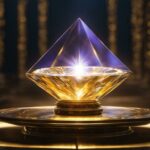Moonlight charging is a popular method for cleansing and energizing crystals, but not all crystals are suitable for this charging method. It is important to understand the properties of each crystal and their interactions with lunar energy. Some crystals, like moonstone, selenite, labradorite, amethyst, and rose quartz, resonate well with moonlight charging.
However, certain crystals should not be charged in moonlight due to their delicate compositions or specific charging requirements. Crystals like halite, scolecite, chrysanthemum stone, wulfenite, ulexite, chalcanthite, and gaspéite should be avoided. These crystals may fade, crack, or lose their luster when exposed to moonlight. It is crucial to use alternative methods, such as sunlight or running water, to charge these crystals. Trusting one’s intuition and personal connection with the crystals is also important when deciding the best charging method. Cleansing preparations, including rinsing the crystals under running water and placing them on natural surfaces, should be done before moonlight charging. Proper placement and duration of exposure to moonlight, usually at least six hours, should be considered.
Key Takeaways:
- Not all crystals can be charged in moonlight
- Certain crystals like halite, scolecite, chrysanthemum stone, wulfenite, ulexite, chalcanthite, and gaspéite should be avoided
- Alternative methods like sunlight and running water can be used for these crystals
- Trusting intuition and personal connection with the crystals is important when choosing a charging method
- Proper cleansing preparations, placement, and duration of exposure to moonlight should be considered
Crystals Suitable for Moonlight Charging
Some crystals, like moonstone, selenite, labradorite, amethyst, and rose quartz, resonate well with moonlight charging. These crystals have properties that align harmoniously with the energy of the moon, allowing them to receive and absorb its powerful essence. Moonstone, for example, is known for its connection to feminine energy and intuition. It is believed to enhance emotional balance and spiritual growth, making it an ideal crystal for moonlight charging.
Selenite, on the other hand, is renowned for its cleansing and purifying properties. It has a strong connection to the moon’s energy and is often used to recharge other crystals. Labradorite, with its captivating play of colors, is said to activate one’s inner magic and intuition. This crystal resonates beautifully with the mysterious and transformative energy of the moon.
Amethyst, a popular crystal known for its soothing and protective qualities, is believed to enhance spiritual awareness and psychic abilities. Its calming energies make it a perfect crystal to charge under the moonlight, allowing it to further amplify its healing properties. Lastly, rose quartz, the stone of unconditional love, promotes emotional healing and self-love. By charging it in the moonlight, rose quartz can enhance its nurturing and gentle energies.
| Crystal | Main Properties |
|---|---|
| Moonstone | Connection to feminine energy, emotional balance, spiritual growth |
| Selenite | Cleansing, purification, recharging other crystals |
| Labradorite | Inner magic, intuition, transformation |
| Amethyst | Spiritual awareness, psychic abilities, calming |
| Rose Quartz | Unconditional love, emotional healing, self-love |
These crystals, when charged under the moonlight, can further enhance their already powerful properties. It is important to note that even though these crystals resonate well with moonlight charging, it is still crucial to cleanse and prepare them before exposing them to the lunar energy. By rinsing them under running water and placing them on natural surfaces, their energy is cleared, allowing them to fully benefit from the moonlight’s replenishing and purifying effects. Additionally, consider the placement and duration of exposure to moonlight. Most recommendations suggest leaving the crystals outside for at least six hours, ensuring they have ample time to absorb the moon’s energy.
Crystals Not Suitable for Moonlight Charging
However, certain crystals should not be charged in moonlight due to their delicate compositions or specific charging requirements. Crystals like halite, scolecite, chrysanthemum stone, wulfenite, ulexite, chalcanthite, and gaspéite fall into this category. Exposing these crystals to moonlight can lead to undesirable effects such as fading, cracking, or loss of luster.
When it comes to moonlight charging, it is crucial to understand the unique properties of each crystal. Delicate crystals like halite, with its sodium chloride composition, are highly susceptible to damage when exposed to moisture or direct light. Selenite, known for its softness, can also be affected by moonlight charging as it may result in the crystal crumbling or eroding over time.
Crystals with specific charging requirements, such as chrysanthemum stone, can also be adversely affected by moonlight. This unique crystal, with its intricate flower-like patterns, should be charged using more tailored methods to preserve its delicate beauty and structural integrity. Similarly, wulfenite, ulexite, chalcanthite, and gaspéite have specific properties that make moonlight charging unsuitable for them.
| Crystals Not Suitable for Moonlight Charging | Reasons |
|---|---|
| Halite | Highly susceptible to moisture and direct light |
| Scolecite | Sensitive composition that can be affected by moonlight charging |
| Chrysanthemum Stone | Delicate flower-like patterns require more tailored charging methods |
| Wulfenite | Specific properties make moonlight charging unsuitable |
| Ulexite | Specific properties make moonlight charging unsuitable |
| Chalcanthite | Specific properties make moonlight charging unsuitable |
| Gaspéite | Specific properties make moonlight charging unsuitable |
For crystals that are not suitable for moonlight charging, alternative methods should be considered. Sunlight, for example, can be used as a substitute charging source. Placing these crystals in a sunny spot, preferably in the morning or late afternoon when the sunlight is less intense, can provide the necessary energy for cleansing and rejuvenation.
Another alternative method is using running water. Crystals that should not be exposed to moonlight can benefit from rinsing them under running water. This helps cleanse and recharge the crystals without the risk of damage or alteration. Placing the crystals on natural surfaces, such as a riverbed or under a waterfall, can enhance the connection with nature’s energy.
Ultimately, understanding the specific properties and requirements of each crystal is essential in determining the most suitable charging method. Trust your intuition and personal connection with the crystals when making this decision. By taking these factors into account, you can ensure the longevity and optimal energy of your crystals.
Alternative Charging Methods
It is crucial to use alternative methods, such as sunlight or running water, to charge crystals not suitable for moonlight charging. These crystals, like halite, scolecite, chrysanthemum stone, wulfenite, ulexite, chalcanthite, and gaspéite, may fade, crack, or lose their luster when exposed to moonlight. By opting for alternative charging methods, you can protect the integrity and energy of these delicate crystals.
Sunlight is a powerful source of energy that can effectively cleanse and recharge crystals. Find a spot where the crystals can bask in direct sunlight for a few hours. Remember to place them on a natural surface, such as a piece of wood or a bed of salt, to enhance their connection to nature. This method is particularly beneficial for crystals that thrive in sunlight, like citrine or clear quartz.
Another alternative charging method is running water. Hold the crystals under gently flowing water, visualizing any negative or stagnant energy being washed away. You can also submerge them in a natural body of water, such as a river or the ocean, for a more profound cleanse. This method is especially suitable for crystals associated with the water element, like aquamarine or larimar.
| Alternative Charging Methods | Crystals to Use |
|---|---|
| Sunlight | Citrine, clear quartz |
| Running Water | Aquamarine, larimar |
When deciding on the best charging method for your crystals, trust your intuition and personal connection with them. Each crystal has its own energy signature and may respond differently to various methods. Experimentation and listening to your instincts will help you find the most effective way to cleanse and energize your crystals.
Conclusion
Understanding the properties of crystals and their unique charging requirements will help determine the best method for each crystal. Moonlight charging is a popular choice for cleansing and energizing crystals, but it is important to note that not all crystals are suitable for this method. While crystals like moonstone, selenite, labradorite, amethyst, and rose quartz resonate well with moonlight charging, there are certain crystals that should not be exposed to moonlight.
Crystals such as halite, scolecite, chrysanthemum stone, wulfenite, ulexite, chalcanthite, and gaspéite should be avoided when it comes to moonlight charging. These crystals have delicate compositions or specific charging requirements that may cause them to fade, crack, or lose their luster when exposed to moonlight. To ensure the long-lasting beauty and energetic properties of these crystals, alternative charging methods such as sunlight or running water should be used.
When deciding the best charging method for your crystals, it is essential to trust your intuition and personal connection with them. Each crystal has its own energy and resonance, and you may sense which method aligns best with their needs. Before moonlight charging, it is recommended to cleanse the crystals by rinsing them under running water and placing them on natural surfaces. Additionally, consider the proper placement and duration of exposure to moonlight, typically at least six hours, to optimize the charging process.
Ultimately, while all crystals can benefit from the gentle energy of the moon, understanding their unique properties is the key to determining the most suitable charging method. By choosing the right approach, you can ensure that your crystals receive the cleansing and energizing they need to support you on your spiritual journey.
Do the Crystals That Glow Under Black Light Also React to Moonlight?
Crystals that glow under black light possess a unique property that makes them vividly emit light in the dark. However, they do not react to moonlight as they selectively absorb and emit specific wavelengths of light. This fascinating phenomenon is due to the crystals’ ability to absorb energy and release it as visible light, resulting in their enchanting glow under black light.
FAQ
Which crystals cannot be charged in moonlight?
Crystals like halite, scolecite, chrysanthemum stone, wulfenite, ulexite, chalcanthite, and gaspéite should not be charged in moonlight due to their delicate composition or specific charging requirements.
Which crystals are suitable for moonlight charging?
Crystals such as moonstone, selenite, labradorite, amethyst, and rose quartz resonate well with moonlight charging and can benefit from the energy of the moon.
What are alternative charging methods for crystals not suitable for moonlight charging?
Crystals that should not be charged in moonlight can be charged using alternative methods such as sunlight or running water. Trusting your intuition and personal connection with the crystals is also important for determining the best charging method.
What preparations should be done before moonlight charging?
Before moonlight charging, it is important to cleanse the crystals by rinsing them under running water and placing them on natural surfaces.
How long should crystals be exposed to moonlight during charging?
It is recommended to expose crystals to moonlight for at least six hours during the charging process.








